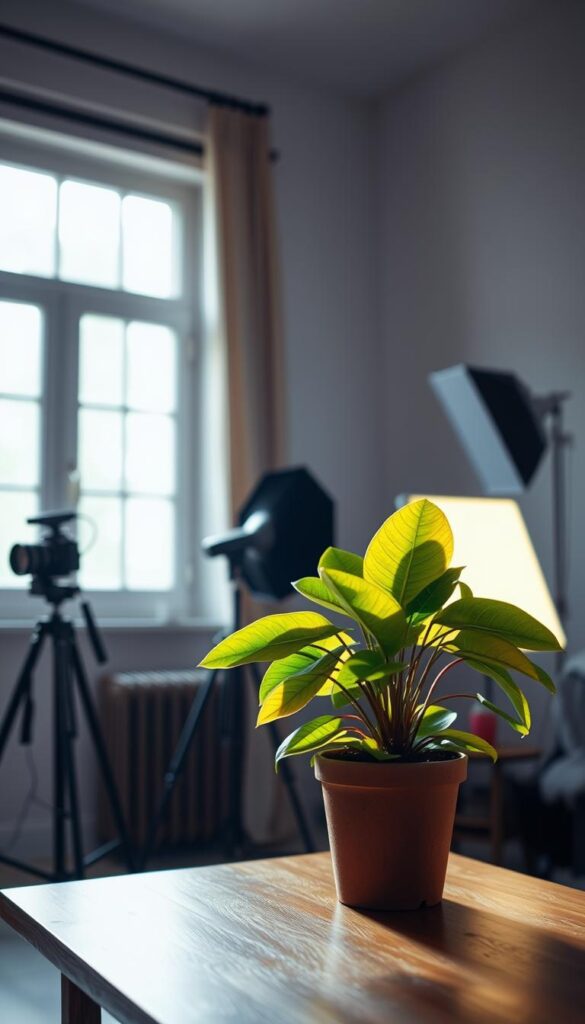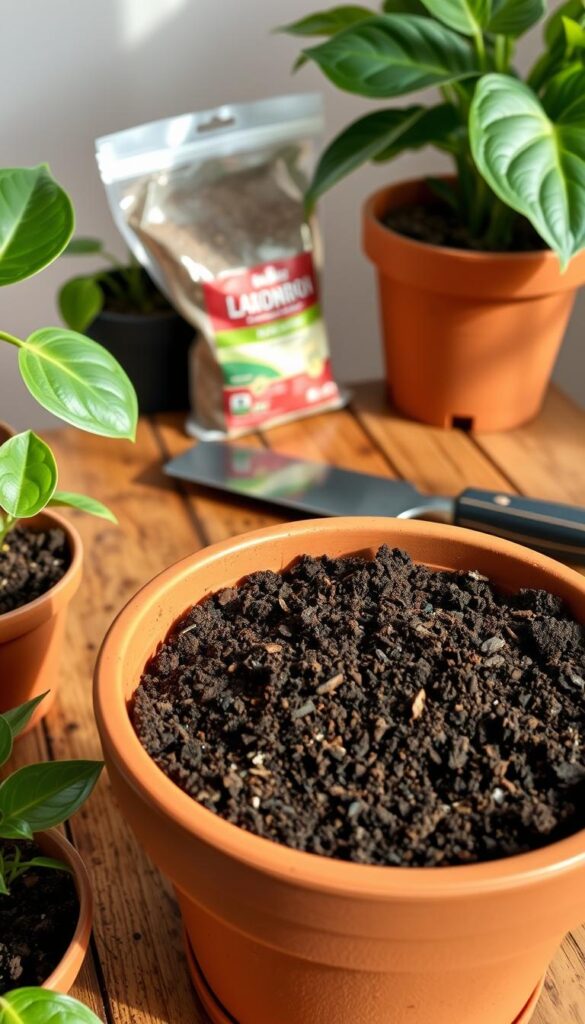My journey with the Philodendron Ring of Fire began like many others—captivated by its striking foliage. This plant’s transformation from deep greens to fiery hues of red, orange, and white is nothing short of magical. It’s a true showstopper that brings a tropical vibe to any room.
What makes this plant special? Its ability to thrive indoors with the right attention. Proper lighting, careful watering, and optimal positioning are key to keeping it vibrant. Originating from tropical climates, it’s a challenge I gladly accepted to nurture in my home.
In this guide, I’ll share my personal tips and essential advice to help you bring out the best in your Philodendron Ring of Fire. From understanding its lighting needs to mastering propagation, I’ll cover it all. Whether you’re a seasoned plant enthusiast or just starting out, this guide is here to ensure your plant flourishes.
Introducing My Philodendron Ring of Fire Journey
My adventure with the Philodendron Ring of Fire began when I stumbled upon its striking, multi-colored leaves at a local nursery. The vibrant hues of red, orange, and white were unlike anything I had seen before, and I was immediately captivated by its unique beauty.
My First Encounter and Inspiration
During my first encounter, I was drawn to the plant’s dramatic foliage, which resembled a ring of fire. The leaves seemed to glow, and I knew right then that this plant would become a centerpiece in my collection. What inspired me most was how the leaves transformed as the plant grew, revealing new colors and patterns.
What Makes It So Special
The Philodendron Ring of Fire is more than just a decorative plant; it’s a challenge and a reward. The interplay of light and growth patterns is fascinating, as the plant adapts to its environment. Proper watering and soil quality are crucial for the leaves to develop their vibrant display. Every step in its care, from selecting the right soil to observing its growth, has deepened my passion and expertise.
https://www.youtube.com/watch?v=c1xKitNsOWk
Reflecting on my journey, I’ve learned that nurturing this plant requires patience and attention to detail. Overcoming challenges like maintaining the right humidity and temperature has been rewarding, and each success has fueled my enthusiasm. The Philodendron Ring of Fire is not just a plant; it’s a continuous learning experience that brings joy and beauty to my home.
Mastering Ideal Light Conditions for Your Plant
Discovering the right light balance for my plant has been a fascinating journey. I quickly learned that bright, indirect light is essential for maintaining its vibrant colors.
Bright, Indirect Light Essentials
I position my plant near a window to ensure it receives plenty of indirect light without direct sun exposure, which can scorch the leaves. Placing it by an east or west-facing window provides the perfect amount of light. This setup helps preserve the striking color patterns on the leaves.
Supplementing with Grow Lights When Needed
During darker months, I use grow lights to supplement the natural light. This ensures the plant’s colors stay vibrant. I’ve found that adjusting the light environment is crucial for maintaining the plant’s health and appearance. By avoiding direct sunlight and using grow lights when necessary, I’ve overcome common pitfalls like fading colors and scorched leaves.

philodendron ring of fire care guide
Attentive care is the cornerstone of nurturing a thriving Philodendron Ring of Fire. By mastering a few key techniques, you can ensure your plant remains healthy and vibrant year-round.
Watering Techniques That Prevent Root Rot
To prevent root rot, I use a moisture meter to check soil dryness between waterings. This tool helps me ensure the soil isn’t too wet or dry, maintaining the perfect balance. I also allow the top inch of soil to dry out completely before watering again. This method has been crucial in keeping my plant’s roots healthy and strong.
Maintaining Proper Humidity and Temperature
Humidity plays a significant role in the plant’s health. I use a pebble tray or a small humidifier, especially during winter when indoor air is drier. This helps maintain the ideal humidity levels without overdoing it. Temperature is equally important, with the sweet spot being between 65°F and 80°F. I avoid placing the plant near drafty windows or extreme heat sources to prevent stress.
Seasonal adjustments are key. During winter, I reduce watering and rely more on my humidifier to maintain moisture. This careful balance ensures my Philodendron Ring of Fire continues to thrive, even when conditions change.
Selecting the Perfect Soil and Potting Mix
Selecting the right soil and potting mix is crucial for the health of your plant. A well-draining mix ensures healthy root growth and vibrant foliage. I’ve learned that the ideal mix should be rich in organic matter and structured to prevent waterlogging.
Choosing a Well-Draining Soil Blend
A well-draining soil blend is essential for mimicking the plant’s natural tropical environment. I look for mixes that balance organic content with drainage properties. This balance supports robust root development and ensures the plant’s colors remain vibrant.
Enhancing Drainage with Perlite and Orchid Bark
To improve drainage, I incorporate perlite and orchid bark into my potting mix. Perlite adds air pockets, while orchid bark enhances water retention without causing root rot. These additions create a mix that breathes and retains moisture optimally.
| Component | Benefits |
|---|---|
| Organic Matter | Supports root health and nutrient absorption |
| Perlite | Improves drainage and aeration |
| Orchid Bark | Enhances water retention and structure |
Using the right mix not only supports growth but also enhances foliage health. Regular repotting with fresh soil ensures long-term beauty and vitality. The perfect potting mix is key to a thriving, colorful plant.

Propagation and Nurturing Vibrant Foliage
Propagating and nurturing your plant’s vibrant foliage is an exciting part of its care journey. This process not only allows you to share plants with friends but also helps maintain the health and beauty of your current specimen.
Effective Stem Cutting Methods
To propagate, I recommend taking 4-6 inch stem cuttings with at least two nodes. The best time is during the growing season when the plant is actively producing new growth. Using clean tools, cut just below a node and remove lower leaves to promote rooting. Place the cutting in water or a rooting medium, ensuring the node is submerged. Roots typically develop within a few weeks.
For optimal results, I follow a step-by-step process: prepare the cutting, plant it in moist soil, and maintain humidity until roots form. This method preserves the plant’s variegation and encourages healthy growth.
Using Pruning and Support for Healthy Growth
Pruning is essential for removing damaged leaves and stimulating fuller growth. I use clean scissors to trim back overgrown stems, which helps the plant focus its energy on producing vibrant foliage. Additionally, providing support with trellises or moss poles guides vertical growth and keeps the plant upright and balanced.
By following these propagation and nurturing techniques, you’ll be able to enjoy the beauty of your plant’s foliage while sharing its vibrant colors with others. Celebrate small victories, like successful propagation, and continue to refine your care techniques for a thriving specimen.
Styling Your Space with a Touch of Tropical Flair
Transforming your home into a lush oasis starts with creative styling. The Philodendron Ring of Fire, with its vibrant leaves, is the perfect centerpiece for any room. By choosing the right pots and displays, you can highlight its striking foliage and add a tropical vibe to your space.
Creative Display Ideas for Indoor Living
I love experimenting with unique pots that complement the plant’s fiery accents. A ceramic pot with an orange glaze can enhance the leaf’s warm tones, creating a stunning focal point. For a more rustic look, wicker planters add natural charm and texture to your space.
Don’t be afraid to think outside the pot! Hanging planters or wall-mounted displays can showcase the plant’s trailing stems beautifully. I’ve even repurposed an old wooden ladder as a multi-level display for my houseplant collection. It’s a fun way to add visual interest and maximize space.
Pairing with Complementary Houseplants
Grouping your Philodendron Ring of Fire with other tropical houseplants creates a dynamic and cohesive look. I pair mine with a Prayer Plant for its striking leaf patterns and a Dracaena for height and texture. This mix adds depth and character to any room.
When arranging, consider the natural light each plant needs. Place the Philodendron near a bright window and position others around it based on their requirements. This balanced approach ensures every plant thrives and contributes to the tropical ambiance.
Remember, styling is all about experimentation. Try different arrangements until you find what works best for your space. The right setup can turn any room into a vibrant tropical retreat, where every houseplant shines.
Final Thoughts on Caring for Your Fiery Philodendron
As I reflect on my journey with this stunning plant, I’m reminded of the importance of vigilance and prompt action. Common issues like root rot and leaf spot can arise, often caused by overwatering or poor air circulation. Addressing these problems early is key to maintaining your plant’s health throughout the year.
Understanding each care level—from watering to light—plays a crucial role in long-term success. Regular checks for subtle changes can prevent larger issues. My personal tips include using a moisture meter and ensuring good air flow to avoid root rot.
Trust your journey and remain patient. Every challenge is an opportunity to learn and grow. I invite fellow enthusiasts to share their experiences and join me in embracing the beauty of tropical plant care.
